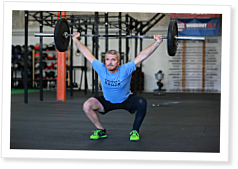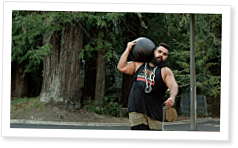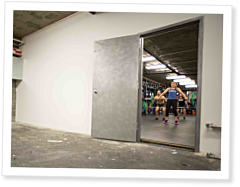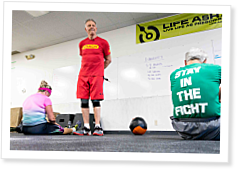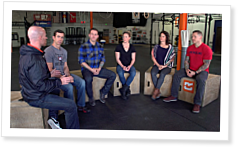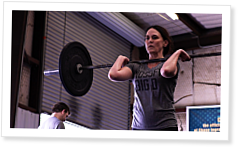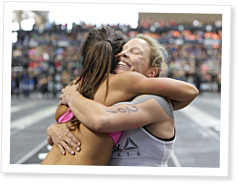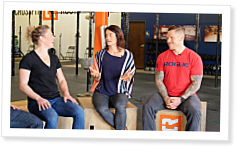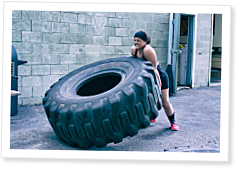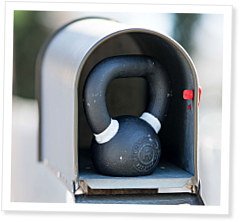
Warning: Reducing intensity can be habit forming. Please consult your CrossFit trainer immediately.
You have to do Fran today.
Stop reading, close your eyes and really think about that for a moment.
Note the freefall feeling in your chest, the sweaty palms and the subtle changes in your breathing.
Now consider this statement:
You have to do Fran in less than 12 minutes today.
I bet you suddenly don't feel nervous at all. You might even view the reps as a warm-up for another workout.
Same weight, same reps, same workout-different results.
Intensity burns. It tastes like a mouthful of old pennies soaked in battery acid. It makes you dizzy. It causes you to writhe around on the ground trying to work the misery out of your muscles. It usually requires a period spent on your back or butt, and sometimes it sends your lunch back the way it came in. Intensity gets caught in your throat and keeps you hacking hours after the workout ends.
Intensity also brings results. Push someone out of the comfort zone and physiology adapts. Do that regularly and fitness improves dramatically. After more than 15 years of workouts on CrossFit.com and six years of the CrossFit Games Open, we can make that statement with certainty backed by data.
Discomfort creates adaptation, but it can be very tempting to avoid the continuous discomfort needed to keep driving adaptation-even as a CrossFit athlete who knows its rewards.
Repetition creates habit, and you can adjust to almost anything-even fairly unpleasant stuff like Fran. I'm sure The Man in the Iron Mask was pretty uncomfortable for the first period of his imprisonment, but after a few years of metal, he was probably well used to flattening out his sandwiches so they would fit through the mouth slot.
Same deal with fitness. As we all know, “beginner's gains” in CrossFit are the reward athletes are given simply for ditching inactivity or a stagnant fitness routine in favor of a superior regimen. When beginner's gains evaporate and the nose must go right to the grindstone for sustained improvement in CrossFit, it can be tempting to get comfortable and step back from intensity. Not all the way back-just enough to take the edge off. Satisfaction with current output can reduce discomfort significantly-and limit results-while the quest for further improvements would bring great reward but also renewed acquaintance with that deep burning sensation.
Reducing intensity can be as subtle as breaking up Fran's 15 thrusters when we don't have to. It's a very minor reduction in effort, and almost no one notices-sometimes not even the athlete. Fran burns a bit less, and only 20 seconds are added to a PR time, giving him or her the opportunity to attribute the score to an off day, bad sleep or “that third burrito at lunch.”
Luckily, the athlete still stays far fitter than if he or she hadn't done Fran, but slacking off a little can lead to slacking off a lot, which is equivalent to treating a CrossFit workout like a 20-minute roll through the sports section while plodding on the elliptical machine.
I realized I was cutting with the wrong side of a very sharp knife a few weeks back in a workout that forced me to push myself:
100 wall-ball shots
Do 13 burpees after any broken set; no resting while holding the ball.
In that workout, my utter hatred of burpees forced me to complete my final set of 45 by pushing into the neighborhood of my physical limit. But my mental limit had come 30 reps into that last set, when I normally would have quit had the burpees not been present.
“I can't finish this unbroken,” I thought before a coach saw me mentally crumbling and quickly advised that trading only 15 wall balls for 13 burpees plus 15 wall balls was a bad deal.
So I kept going, and while the 45th rep burned deeply, it was achievable. In fact, I had a few more in me. I had no idea-but my coach did.
The workout and the coach kicked me off the elliptical machine, so to speak, and they highlighted the fact that I'm capable of more than I think I am. I bet you're more capable than you think you are, and your CrossFit coach knows it. Listen to him or her when you're told to keep going and see what happens. When the coach says, “Do 5 more,” do 5 more-even if you think you'll fail. I bet you won't. I bet you'll get fitter.
To get even further out of your CrossFit comfort zone, I'd encourage you to experiment with workouts similar to the wall-ball challenge detailed above.
Air Force, with 4 burpees preceding the work every minute, is a good example of a nowhere-to-hide workout.
Or try 500-meter rowing or 400-meter running repeats with a thruster penalty for every second under a certain challenging but achievable time.
Another option: Create a workout with a scheme about 2 reps out of your comfort zone and vow to do all sets unbroken. Fran at 23-17-11 might present an excellent challenge even if it lacks the mathematical grace of the original prescription.
Or you can create workouts in which a certain number of reps must be completed every 60 seconds. If you pick the right amount of work for your fitness level-say 15 wall-ball shots and 10 heavy kettlebell swings, for example-you're going to have to work hard and go unbroken to get the work done in each minute.
To reap the greatest benefits from CrossFit, you have to be willing to push yourself, to be uncomfortable, to suffer for reward. And most of us are most of the time. The whiteboard and the rivalries thereon are powerful motivational tools. Still, a 5-minute Fran can become a habit if you let your mind trick you into dropping the barbell well before you need to.
Remember: Objects in motion tend to stay in motion, while objects at rest tend to head to the chalk bucket.
About the Author: Mike Warkentin is the managing editor of the CrossFit Journal and the founder of CrossFit 204.




